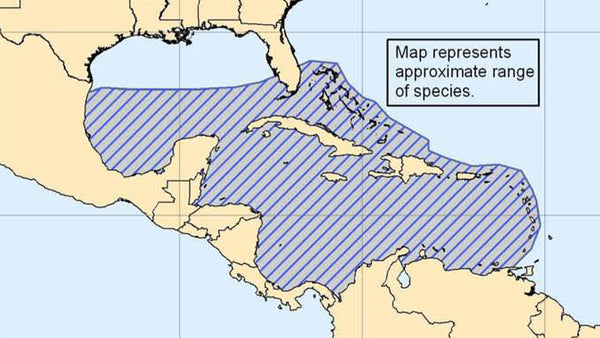Siren Spotlight: Caribbean monk seal September 29, 2015 18:33
From Jess:
When I first began developing "Rescue Sirens," I wanted our mermaids to be examples of convergent evolution: the phenomenon by which organisms of unrelated lineages show similar adaptations due to comparable environmental influences. In other words, animals that occupy the same biological niche share the same types of features because they're doing the same kind of things.
Since the mermaids in "Rescue Sirens" live in the waters around South Florida, most of them have lower bodies that resemble marine life native to that area (Nim being the sole exception, with her fantastical "classic" mermaid tail). Tiger sharks (Kelby), common dolphins (Maris), and blue marlins (Echo) are pretty obvious choices for South Florida sea creatures, but the one tail that regularly throws people for a loop is Pippa's, which looks like a seal tail.

Pippa, drawn by Chris Sanders and colored by Edgar Delgado.
Most people we've talked to assume Pippa's tail is supposed to be a harbor seal's. "Since when do harbor seals live off the coast of Miami?", we've been asked.
With the exception of the occasional wayward individual (like "Sunny," a young harbor seal rescued in New Smyrna Beach, Florida back in 2004), East Coast harbor seals like to stick around the chilly North Atlantic; you may see them as far south as North Carolina, but they're not adapted to warmer waters. A harbor seal wouldn't do well in Miami Beach.
But Pippa's tail is not modeled after a harbor seal. Her environmental inspiration is the Caribbean monk seal.

A captive Caribbean monk seal in the New York Aquarium, 1910. Photo courtesy of the US Fish & Wildlife Service.
Not much is known about the Caribbean monk seal. In fact, this species of seal hasn't been seen since 1952, when a small colony was sighted on the Seranilla Bank between Honduras and Jamaica. Despite that, the species was listed as "endangered" until 2008, when the National Oceanic and Atmospheric Adminstration's National Marine Fisheries Service (NMFS) completed a five-year status review and determined the Caribbean monk seal to be extinct.
Caribbean monk seals used to inhabit the waters of the Caribbean Sea, the western Atlantic Ocean, and the Gulf of Mexico; they hauled out on the sands of the Florida Keys and South Florida as well as Cuba and Jamaica, and they had breeding grounds in the Bahamas and Mexico. They are the only species of seal ever known to be native to the Gulf of Mexico and the Caribbean Sea.

The Caribbean monk seal's historic range. Map courtesy of NOAA's NMFS.
So what happened to the Caribbean monk seal? Their only predators were sharks -- and man. Christopher Columbus first described the Caribbean monk seal in 1494 and referred to them as "sea wolves." Upon discovering the animals resting on a beach, he had his crew kill eight of them immediately. Caribbean monk seals were docile and didn't flee from humans, making them exceptionally easy prey for fishermen, sailors, and whalers who wanted the seals' pelts, meat, and oil. According to the "Catalogue of the Specimens of Mammalia in the Collection of the British Museum," "as early as 1688, sugar plantations owners sent out hunting parties to kill hundreds of seals every night in order to obtain oil to lubricate the plantations' machinery." With that kind of mass slaughter taking place, the Caribbean monk seals' numbers had dwindled to the point that they could no longer be commercially hunted by 1850.
What probably finished off the Caribbean monk seal, though, was the decimation of their food source. Even the tiny remaining populations of Caribbean monk seals couldn't be supported by the tropical reefs where they fed due to constant overfishing by humans, and no real effort was made to protect the species. The Caribbean monk seal was placed on the Endangered Species List in 1967, fifteen years after the last reported sighting, so odds are good that it was already extinct.
Today, the Caribbean monk seal is survived by its relatives, the Hawaiian monk seal and the Mediterranean monk seal. However, both species are critically endangered; it's estimated that there about 1,100 Hawaiian monk seals alive in the wild, and only around 600 Mediterranean monk seals. But there's potentially good news: according to Loren McClenachan and Andrew B. Cooper, who published a study on the historical population structure of the Caribbean monk seal, "although [Caribbean monk seal] colonies on the edge of the range were eliminated quickly, the persistence of those in the centre and on offshore atolls indicates that monk seals are resistant to moderate to intense levels of human disturbance, which suggests that proper protection has the potential to save the remaining Hawaiian and Mediterranean monk seal colonies from extinction."
Hunting thankfully isn't the problem today that it was for the Caribbean monk seal centuries ago, but modern monk seals must still deal with the effects of overfishing as well as habitat loss, pollution, and entanglement in marine debris, so they have a number of hurdles to overcome. But people can help. The Save Monk Seals Project at the University of California at Santa Cruz states that "over 20% of the remaining [Hawaiian] monk seal population is alive today due to scientists and volunteers working together," so people can make a difference.
While the Caribbean monk seal, the only seal species that ever swam and played around Miami, has been lost to us, it may not be too late for the remaining two species of monk seals to recover if we can learn lessons from the past.

Pippa and a monk seal friend, drawn by artist Giada Carboni (giadin-a.tumblr.com).
Further reading:
Caribbean Monk Seal: Gone But Not Forgotten - U.S. Fish and Wildlife Service
Caribbean Monk Seal (Monachus tropicalis) - Office of Protected Resources - NOAA Fisheries
